The Office 365 CLI provides a quick and easy way to manage your Office 365 tenant from any operating system and any shell.
When you use the Office 365 CLI to connect to your tenant for the first time, you are presented with a Permissions requested prompt from Azure, by accepting this prompt you are consenting to using the PnP Office 365 Management Shell Azure AD application with your tenant as well as the permissions that it requires.
We ask for a wide range to permissions up front, including permissions that require administrative level consent, so that it is easy for to get started with the CLI and try out the commands across many Office 365 CLI workloads in your tenant without having to handle the complexity of managing the permissions for the different commands manually in Azure.
Whilst this is fine for working against development and test environments, using these levels of permissions against production environments is inconvenient and administrators are not comfortable with granting such permissions to a multi-tenant application within their environment.
In this scenario, administrators will want to provide their own Azure AD app registration to use with the CLI to enable greater control over the permissions that are granted.
This tutorial will walk you through how to create your own Azure AD application with permissions restricted to only read information about SharePoint Online Site Collections and how to use this custom application with the Office 365 CLI.
Register Azure AD application in your tenant
We first need to register a new Azure AD application in your tenant, to do this we will need to navigate to the Azure Portal.
Select Azure Active Directory from the global menu, select App registrations in the Azure Active Directory blade and then select the New registration action button to open the Register an application form.
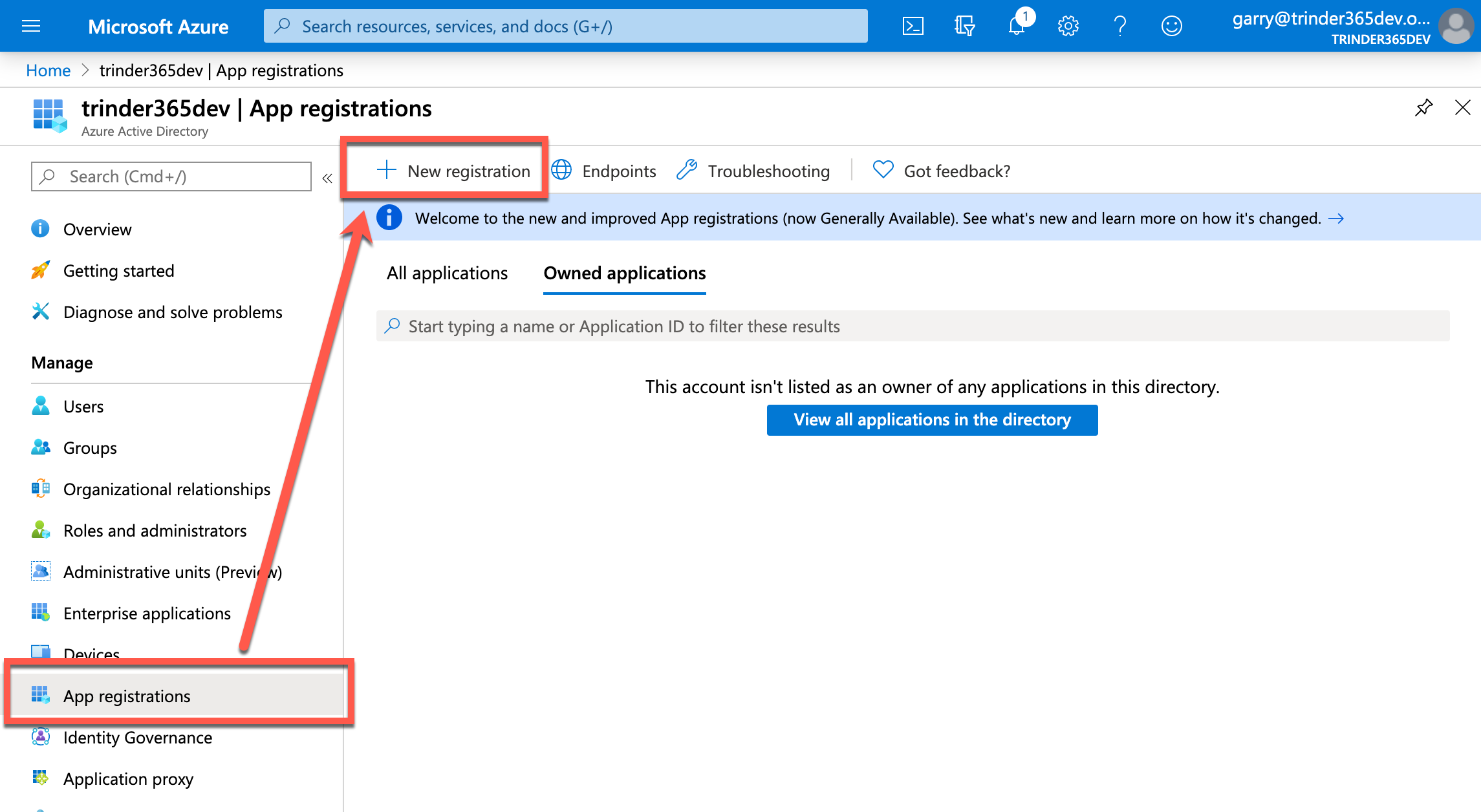
In the form, enter a name for your new application, for the purposes of this tutorial lets use Custom PnP Office 365 CLI, you can always change this later if you want. Leave the Supported account types and Redirect URI as they are and select the Register button at the foot of the form to create your custom application.
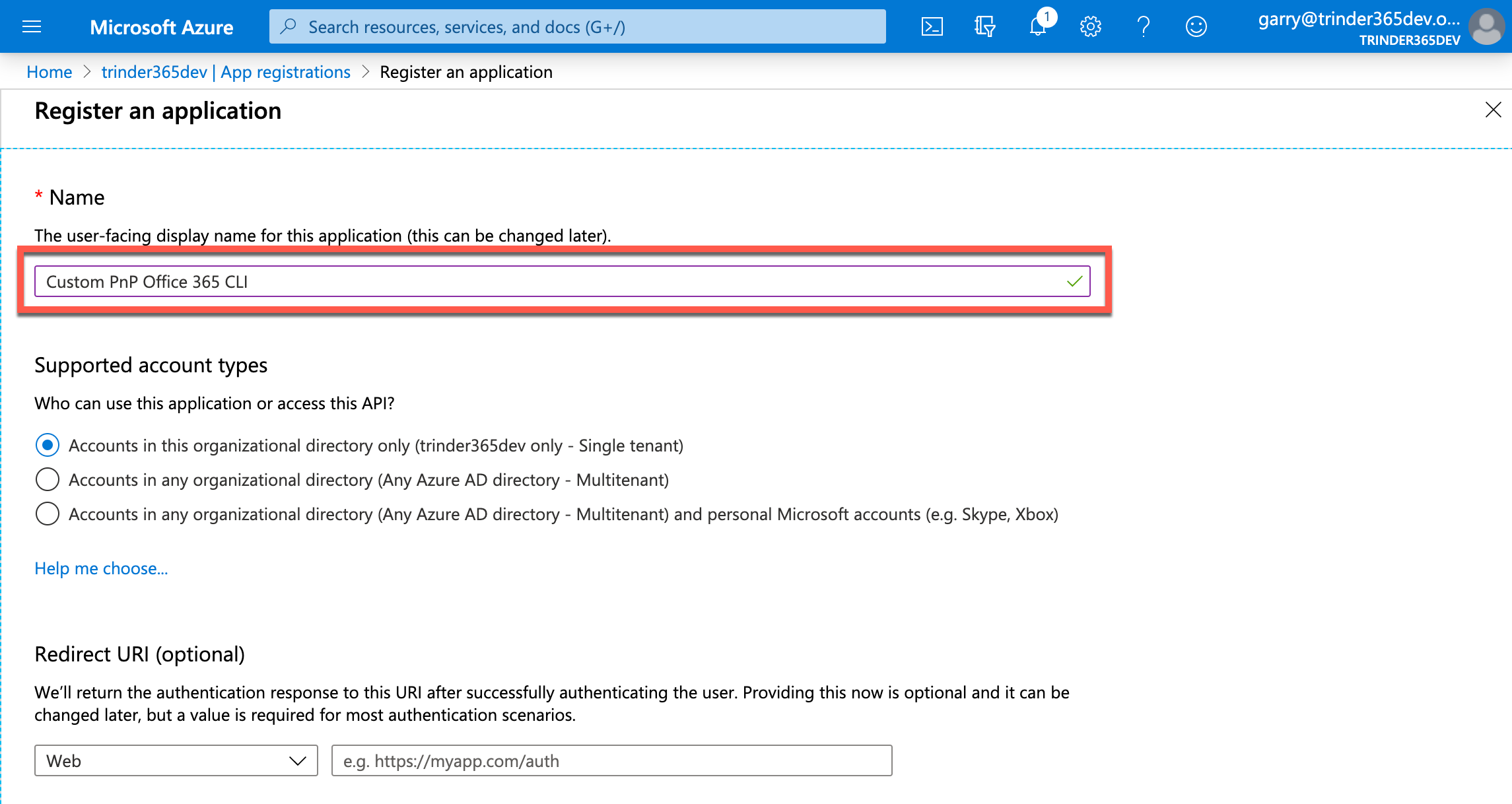
After the application has been created, you will be presented with the blade for your application displaying an overview of some properties of the application. At this point it is a good idea to take note of two key pieces of information that we will need later.

Take a copy of both the Application (client) ID and Directory (tenant) ID values and save them to a place for you to refer back to them later.
Configure Authentication settings
We next need to configure our new application so that it can be used with the Office 365 CLI, to do this we need select Authentication in the Custom PnP Office 365 CLI blade menu.
This will present you with three sections, Platform configuration, Supported account type and Advanced settings.
Select the Add a platform button to open up the Configure platforms menu and select Mobile and desktop applications under the Mobile and desktop applications heading, this will open another menu called Configure Desktop + Devices displaying a section called Redirect URIs and a list of checkboxes with some pre-defined URIs.
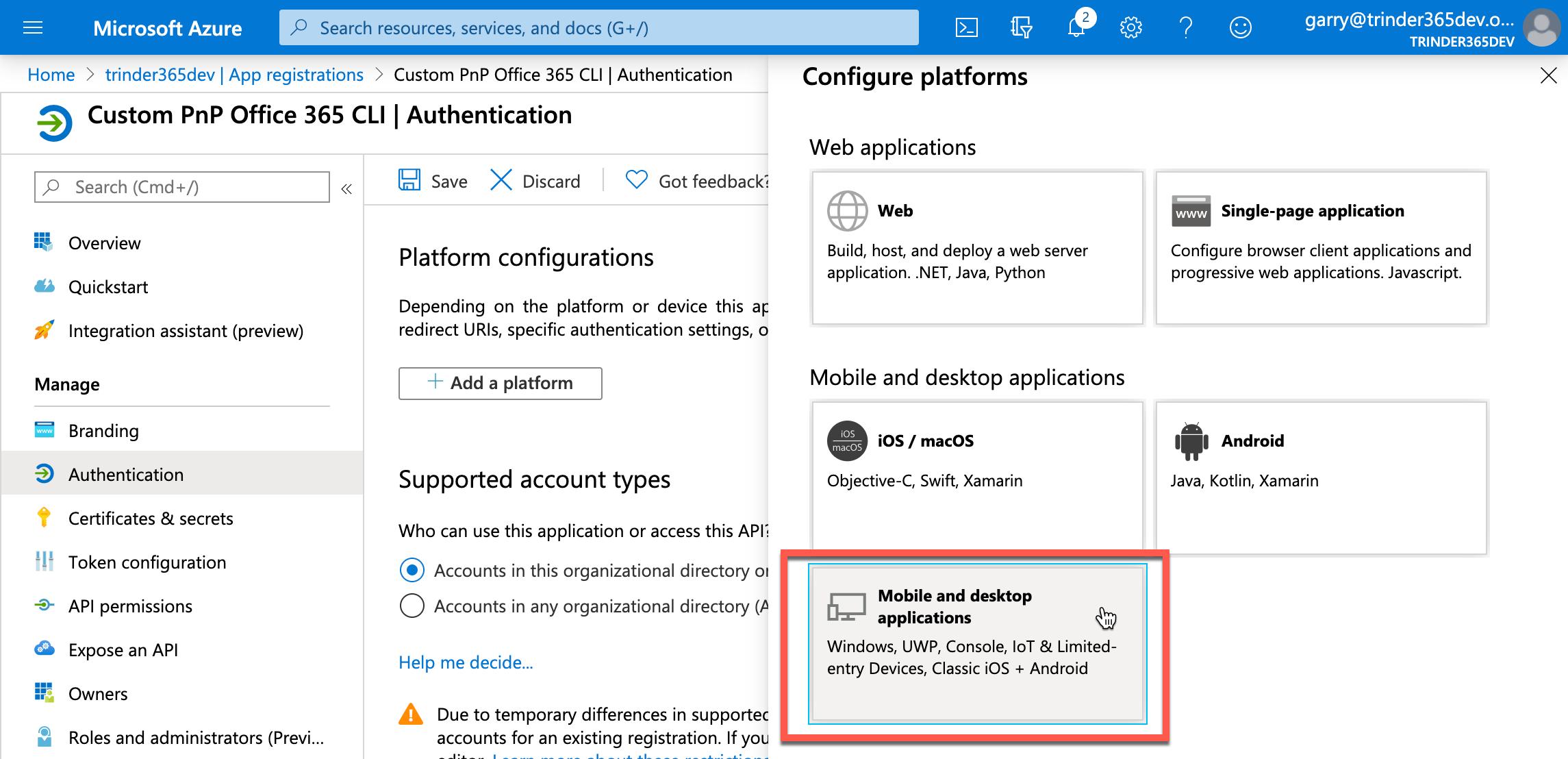
Select the first option in the list, https://login.microsoftonline.com/common/oauth2/nativeclient and select the Configure button at the foot of the menu.
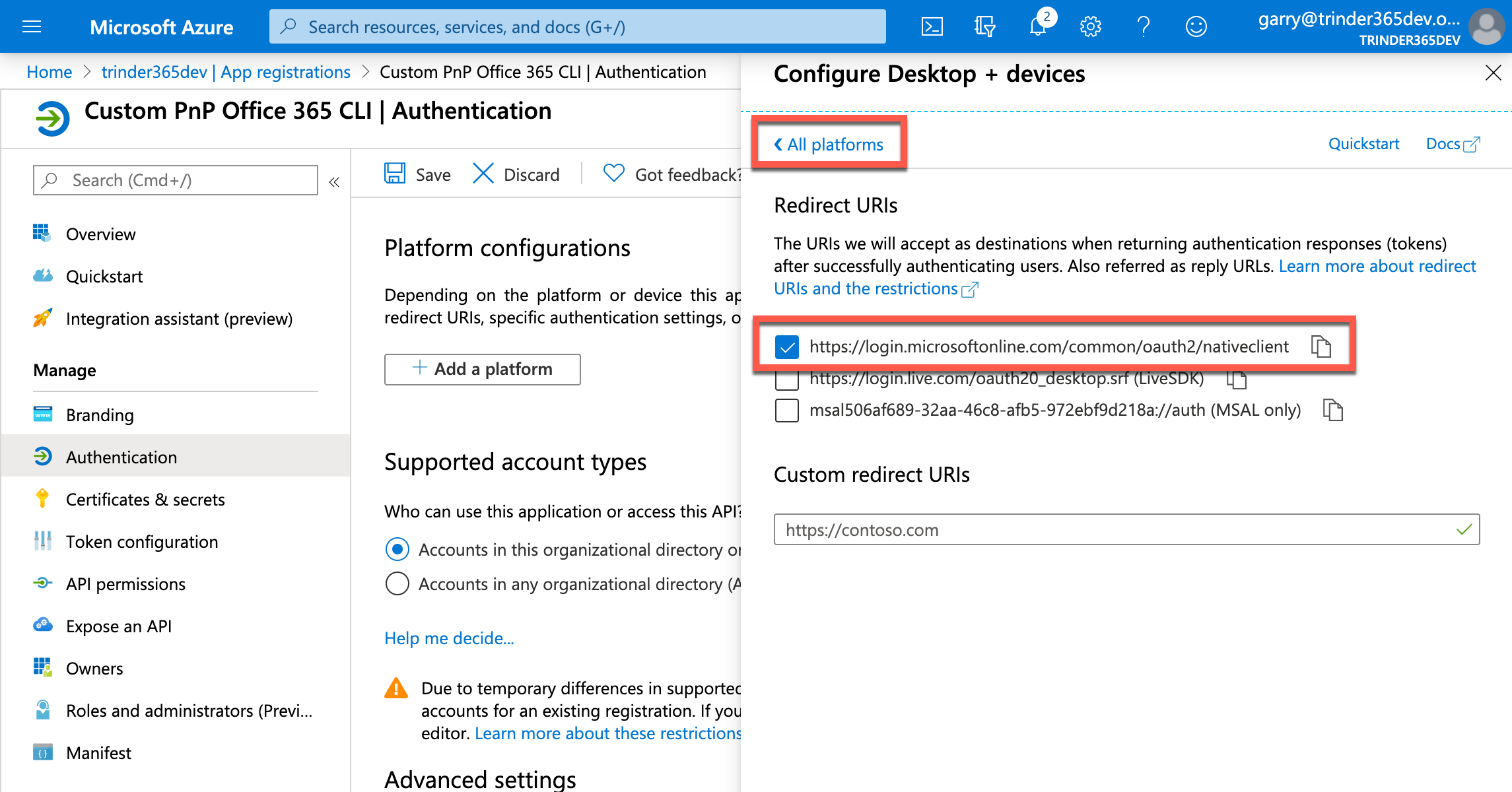
This will refresh the Authentication blade and will display the Redirect URI we just chose from the menu.

This Redirect URI is specific to the use of authentication methods that do not use a web interface for authenticating users and are therefore called
Native Clients, this is the category that the Office 365 falls into.
Moving on, we can skip over the Supported account type section, as this is defaulted to Accounts in this organizational directory only (<tenant> only - Single tenant) it means that only users within the current tenant directory can use this identity and onto the Advanced settings section, in here we need to toggle the Default client type toggle so that is enabled, as we are using the Device code flow method to authenticate to our tenant using the Office 365 CLI.
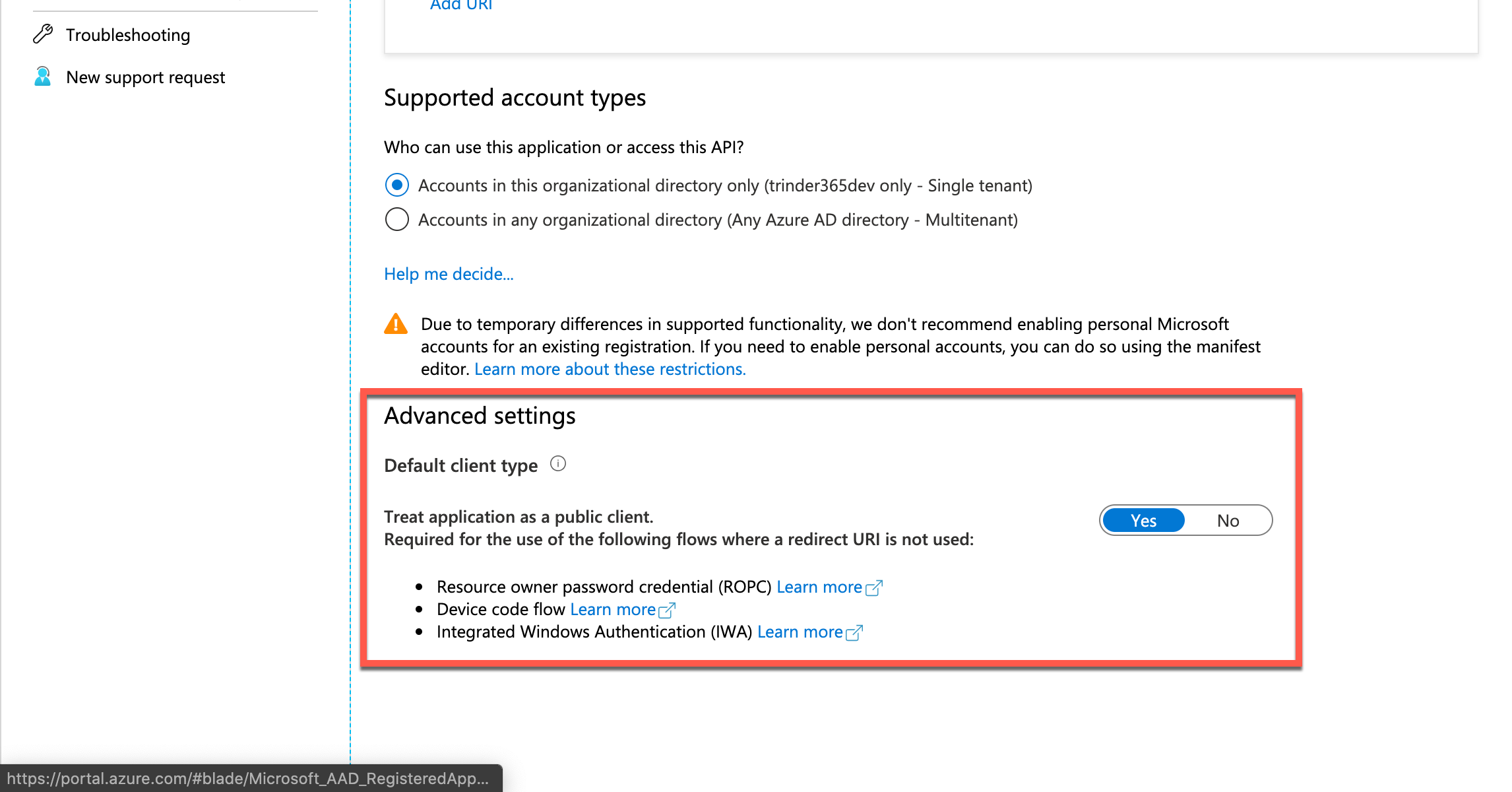
To make sure all these changes are applied, select the Save button before moving on.
Configure API Permissions
Now that we have configured the application to work with the Office 365 CLI, we next need to grant what permissions the CLI will have against our tenant. Select the API permissions in the Custom PnP Office 365 CLI blade menu.
You will see a section called Configured permissions with one permission already granted, this is the default permission which allows the application to sign the user account used when authenticating to the Microsoft Graph.
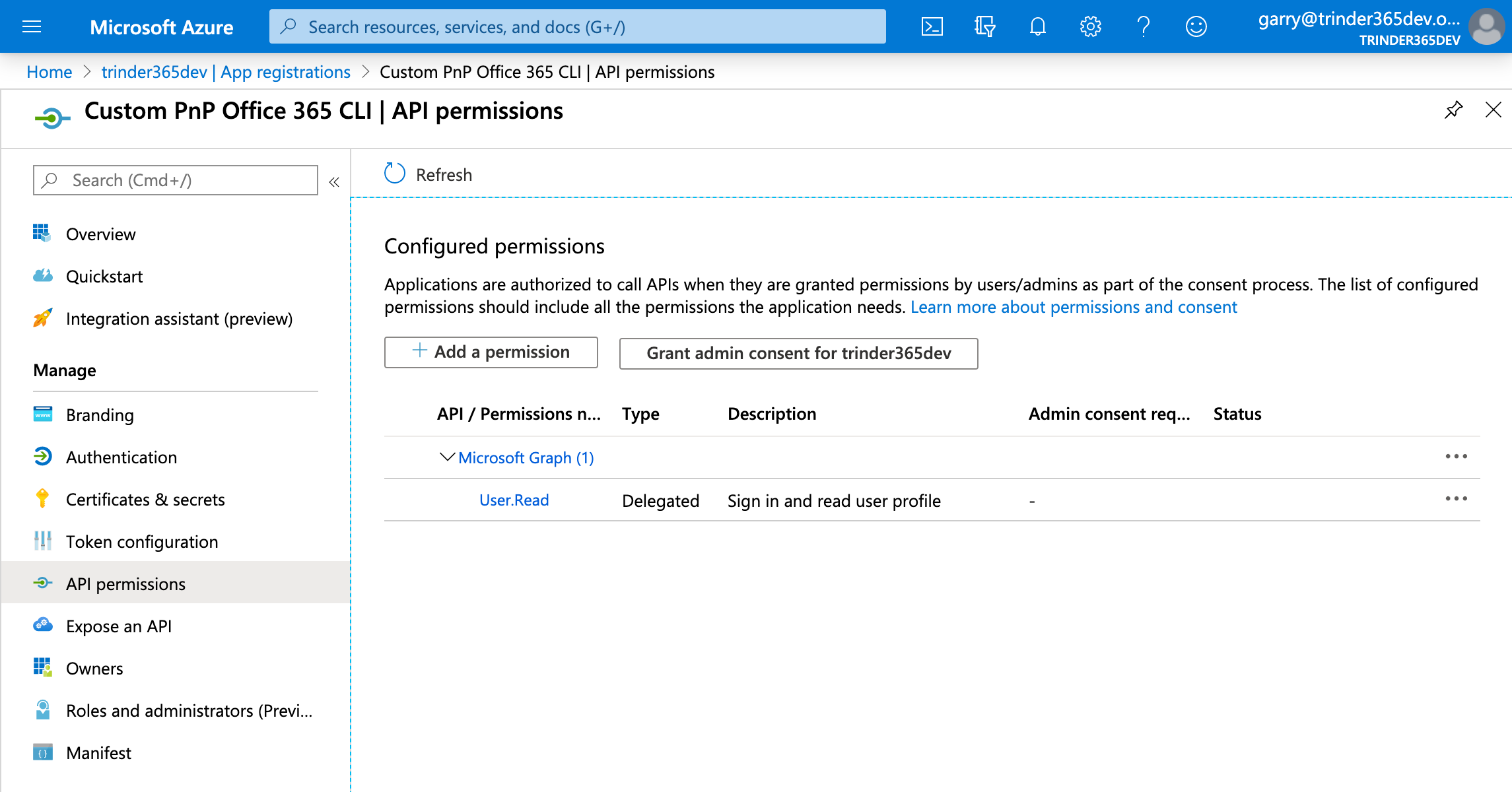
Select the Add a permission button to open the Request API permissions menu, as we are only interested in granting our application access to SharePoint Online for the purpose of this tutorial, select SharePoint in the list of APIs that are available.
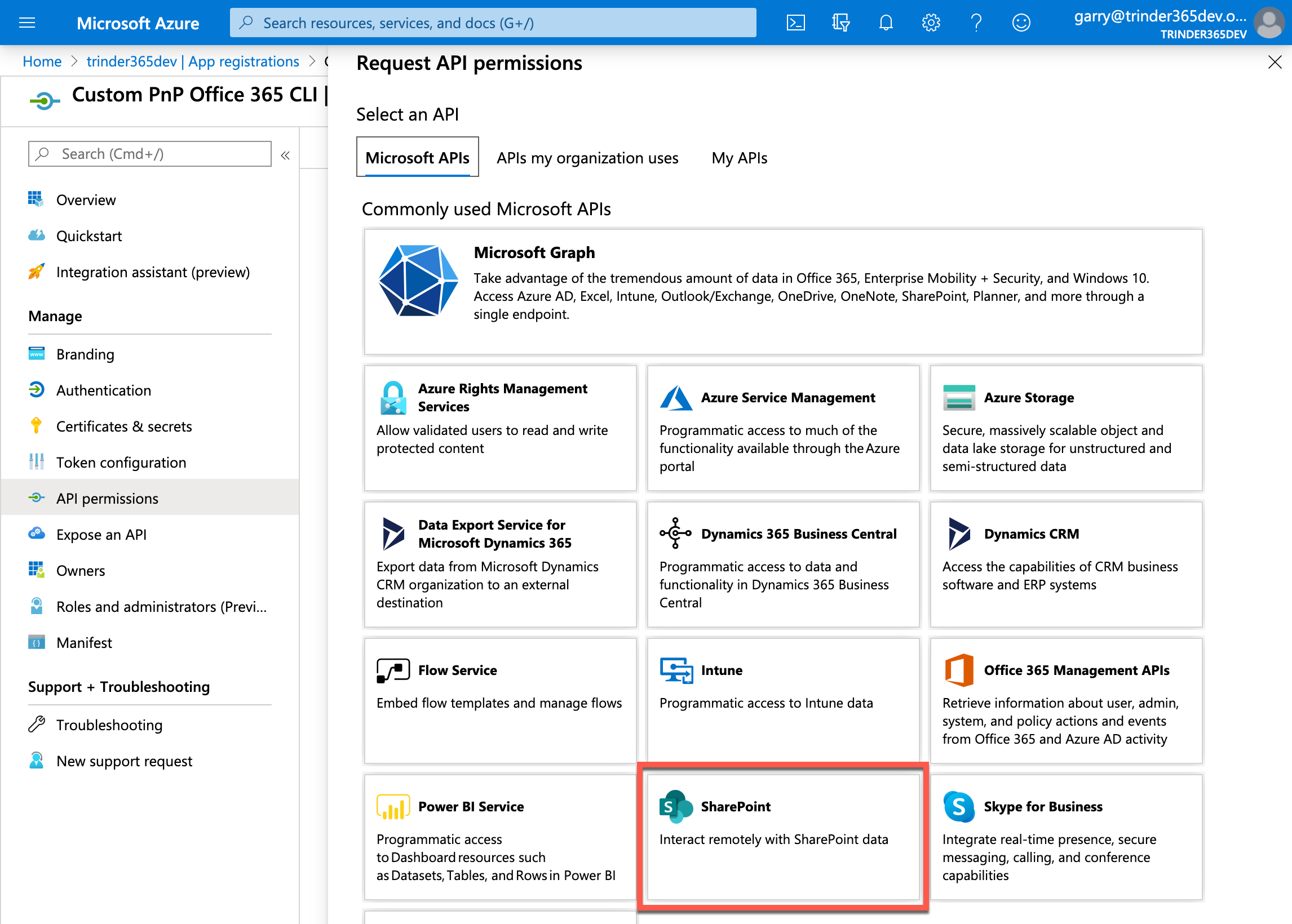
This opens the menu with two options Delegated permissions or Application permissions, as we are going to be communicating with the SharePoint Online APIs as the authenticated user, select Delegated permissions, this will display a list of available permissions that we can choose from.
For the purpose of this tutorial we only want to grant read access to SharePoint Online, so expand the AllSites grouping and select the AllSites.Read permissions and select the Add permissions button to apply these permissions.
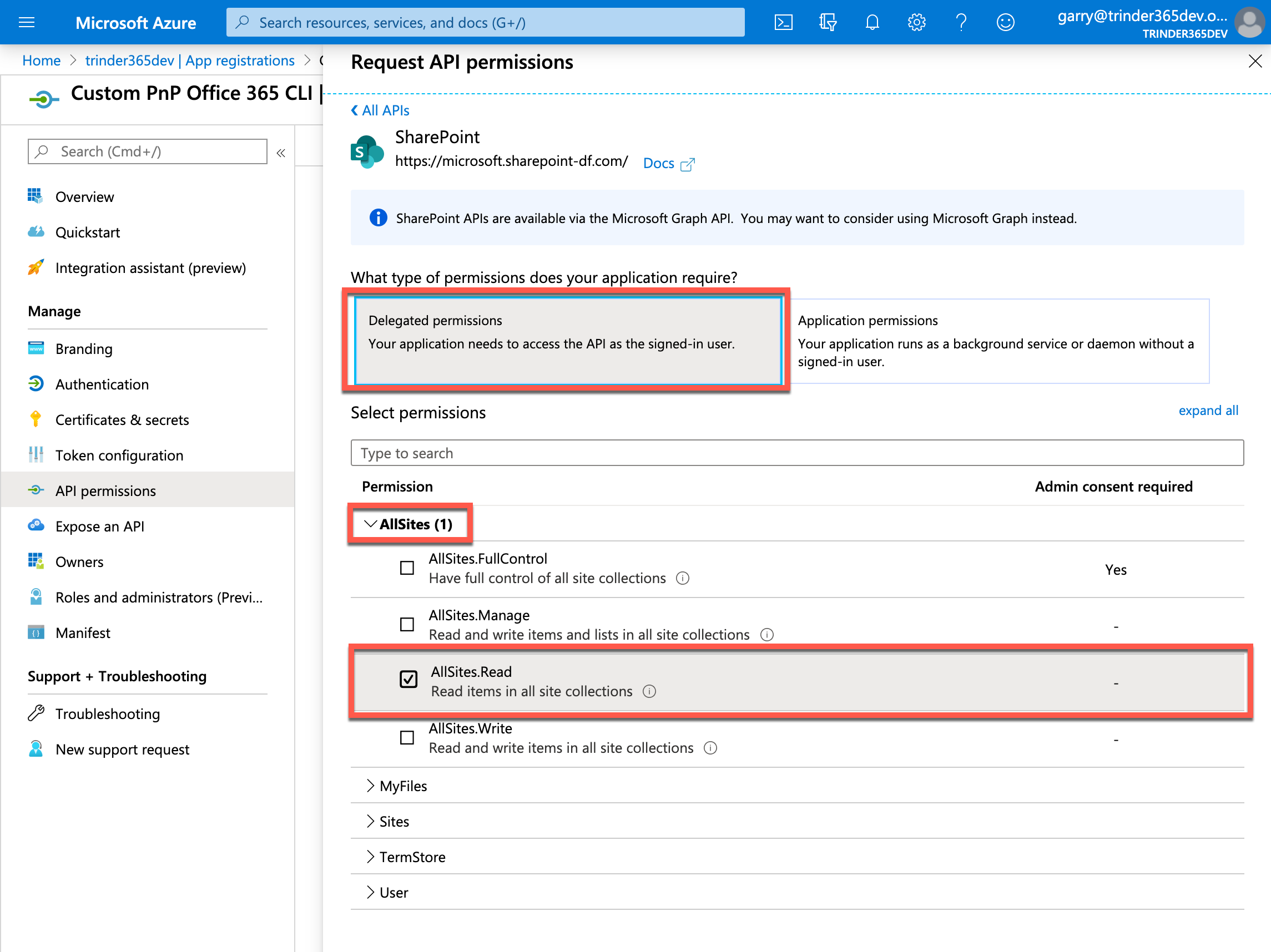
Note that the
AllSites.Readpermission does not directly grant the signed-in user access to all sites in SharePoint Online. As we authenticate as the signed-in user, that user must still have access to the SharePoint sites that we want to return information about, otherwise the SharePoint Online API calls will fail with401 Unauthorized
You will be presented with the Configured permissions section again but this time the AllSites.Read permission will be shown under the SharePoint grouping.
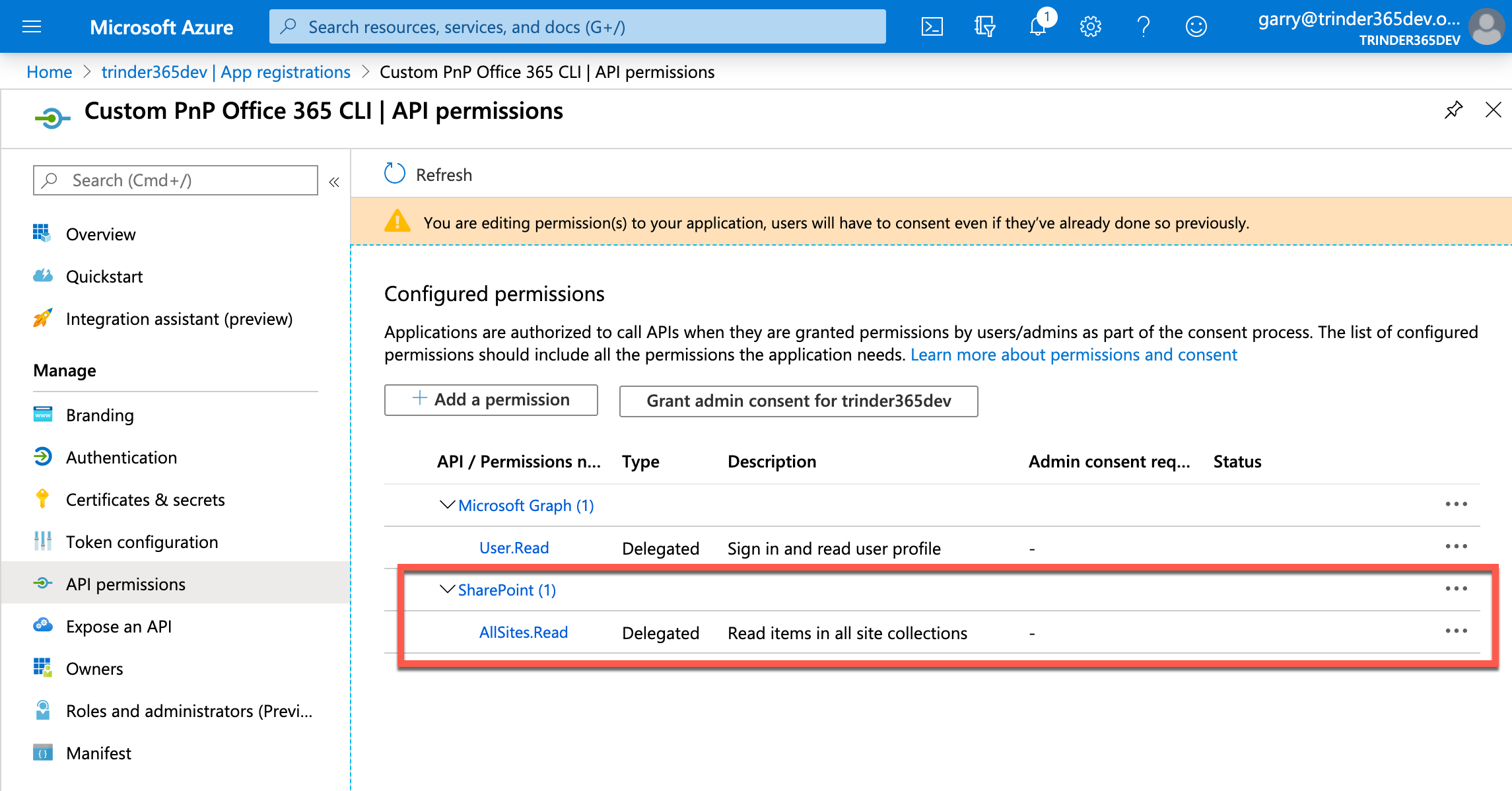
This completes the configuration required in the Azure portal, we can now move onto configuring the Office 365 CLI to use our custom application to login to Office 365.
Create Office 365 CLI environment variables
To configure the Office 365 CLI to use our newly created custom application, we need to tell it the Client ID of our custom application and the Tenant ID of where the custom application has been created.
To do that, we need to create two environment variables, called OFFICE365CLI_AADAPPID and OFFICE365CLI_TENANT, giving them the values that you saved earlier.
How you set the environment variables is dependant on the operating system and shell you are using.
If you are on Windows, you can set the environment variables using the $env:<variable-name> approach in a PowerShell session.
$env:OFFICE365CLI_AADAPPID="506af689-32aa-46c8-afb5-972ebf9d218a"
$env:OFFICE365CLI_TENANT="e8954f17-a373-4b61-b54d-45c038fe3188"
Execute
$env:OFFICE365CLI_AADAPPIDand$env:OFFICE365CLI_TENANTto verify that the environment variables have been created correctly
If you using Linux or MacOS, you can set the environment variables using the export command from your terminal prompt.
export OFFICE365CLI_AADAPPID=506af689-32aa-46c8-afb5-972ebf9d218a
export OFFICE365CLI_TENANT=e8954f17-a373-4b61-b54d-45c038fe3188
Execute
printenvto verify that the environment variables have been created correctly
Now that we have set our environment variables, we are now ready to use our custom application to log in with using the Office 365 CLI.
Login and consent
For the purpose of this tutorial, we will be using the Device code flow to interactively authenticate with an Office 365 CLI tenant. As this is the first time that we will have used the custom application to authenticate, we will also be required to give our consent.
At your terminal session, execute o365 login to start the authentication process, a login device code will be displayed along with a link to a web page where it needs to be entered. Navigate to https://microsoft.com/devicelogin, enter the code into the input field and select Next. You will then be presented with either a login screen or accounts that you have already logged in to Office 365 with. Login with or choose the account from the list that you want to use with Office 365 CLI.
You will now be prompted to consent that the custom application, Custom PnP Office 365 CLI, can use the two permissions that we configure earlier, Read items in all site collections and Sign you in and read your profile on your behalf. Select Accept to consent and complete the sign-in process.
Returning back to your command line, you can now verify that the sign in has been succesful by executing the o365 status command.
Finally, to test that we can indeed read SharePoint Online site collections, lets invoke the following command
o365 spo site get --url https://trinder365dev.sharepoint.com -o json --pretty
The JSON representation of the SharePoint Online site will be returned to the console.
Congratulations! You have just configured the Office 365 CLI to use your own custom application with custom permissions from your own Azure Active Directory.

Find out more
If you would like to know more about Office 365 CLI, visit the web site at https://aka.ms/o365cli.
If you see any room for improvement or suggestions, please don’t hesitate to reach out to us either on GitHub or @office365cli on Twitter.
Appendix: Persisting environment variables
As mentioned earlier, the way in which we set the environment variables meant that they are only set for the lifetime of the session, if the terminal session is closed, you will need to repeat those steps, which maybe undesirable.
How you permanently set the environment variable is dependant on the operating system and shell you are using.
If you are on Windows, you can set the environment variables using the Edit the system environment variables approach in the Windows UI.
Search for Edit the system environment variables in Start Menu and launch it. Select Environment Variables, under the User variables for <user-name> section, select New... to open a dialog. In the dialog, enter OFFICE365CLI_AADAPPID in the variable name field and set the value using the Client ID (quotes should be ommitted), select OK to save the value and repeat the process for the OFFICE365CLI_TENANT variable. Select OK until all windows are closed to persist the changes.
Open a new PowerShell session and execute $env:OFFICE365CLI_AADAPPID and $env:OFFICE365CLI_TENANT to verify that the environment variables have been created correctly.
If you are on Linux or MacOS, depending on your terminal, add the export lines to .bashrc or .zshrc file in your home directory.
If you are using PowerShell Core, it is worth noting that environment variables set in bash or zsh will persist to the pwsh session and the same applies to Windows.

0 comments